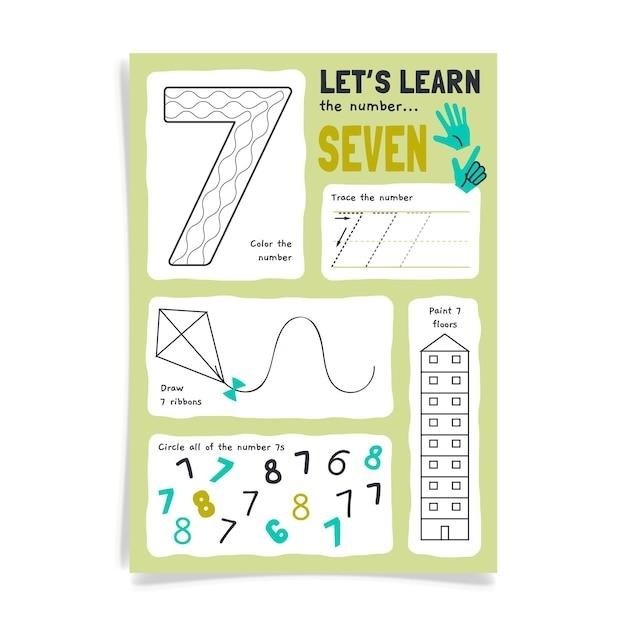
Year 3 Maths Assessment PDFs⁚ A Comprehensive Guide
This guide explores Year 3 maths assessment PDFs, offering insights into various assessment types, resource availability, and effective strategies for interpreting results and using them to improve teaching. Access to online resources and alignment with curriculum standards are also discussed.
Types of Year 3 Maths Assessments
Year 3 maths assessments come in various formats, catering to different needs and learning styles. Arithmetic tests focus on computational skills, evaluating fluency and accuracy in addition, subtraction, multiplication, and division. Reasoning tests, conversely, emphasize problem-solving abilities, requiring students to apply mathematical knowledge to unfamiliar contexts and word problems. Many assessments incorporate both arithmetic and reasoning components to provide a comprehensive evaluation of mathematical understanding. Furthermore, customizable assessments offer tailored evaluations, allowing teachers to pinpoint specific areas needing attention. These may draw from large question banks, enabling targeted practice on particular concepts or skills. The availability of online assessments adds another layer of flexibility, offering instant feedback and efficient marking.
Arithmetic Tests⁚ Focus and Structure
Year 3 arithmetic tests primarily assess a student’s proficiency in fundamental mathematical operations. These tests typically feature a structured format, presenting a series of calculations requiring accurate and efficient solutions. The questions often progress in difficulty, starting with simpler calculations and gradually introducing more complex problems involving larger numbers or multiple steps. A strong emphasis is placed on speed and accuracy, reflecting the importance of computational fluency in mastering more advanced mathematical concepts. The structure often includes sections dedicated to specific operations (addition, subtraction, multiplication, and division), allowing for targeted assessment of individual skills. Time limits are frequently implemented to gauge both speed and accuracy under pressure, mirroring real-world application scenarios. Clear instructions and examples are usually provided to ensure students understand the test’s requirements.
Reasoning Tests⁚ Problem-Solving Skills
Year 3 reasoning tests delve beyond basic calculations, focusing on a student’s ability to apply mathematical knowledge to solve complex problems. Unlike arithmetic tests emphasizing speed and accuracy in computation, reasoning tests prioritize logical thinking and problem-solving strategies. These assessments often present word problems requiring students to interpret information, identify relevant data, and devise a solution plan. Questions may involve multiple steps, requiring students to break down complex problems into smaller, manageable parts. Visual aids, such as diagrams or charts, may be included to help students visualize the problem and develop a solution. The emphasis is on the process of problem-solving, not just the final answer. The ability to explain the reasoning behind the solution is often a key element in evaluating performance. These tests aim to gauge a student’s critical thinking skills and their ability to apply mathematical concepts creatively.
Customizable Assessments⁚ Benefits and Features
Customizable Year 3 maths assessments offer significant advantages over standardized tests. The ability to tailor assessments to specific learning objectives allows teachers to pinpoint areas where individual students need extra support or challenge. These assessments can be created from banks of questions, ensuring a diverse range of problem types. The flexibility to adjust the difficulty level, question types, and number of questions caters to varied student needs and learning styles. Furthermore, customizable assessments allow teachers to incorporate real-world scenarios and context-specific problems, making the learning more relevant and engaging. The availability of audio support for questions benefits students who may struggle with reading. Teachers can use customizable tests for homework or in-class assessments, providing valuable formative data to inform instruction. This targeted approach ensures effective evaluation and allows for personalized learning experiences.

Accessing Online Year 3 Maths Assessments
Numerous websites provide access to online Year 3 maths assessments. These platforms often offer a wide variety of assessment types, including arithmetic and reasoning tests, catering to different learning styles and needs. Many online resources provide instant marking and feedback, saving teachers valuable time and providing immediate insights into student performance. Some websites offer customizable assessments, allowing teachers to create tests tailored to specific curriculum objectives and student needs. Access may require a school license or individual subscription, depending on the platform. Online assessments frequently incorporate interactive elements and technology-enhanced question types. The ability to easily track student progress and analyze results is a key benefit of many online platforms; It’s crucial to select a reputable website that aligns with the curriculum and provides reliable assessment tools.
Year 3 Maths Assessment Resources⁚ Websites and Publishers
Several websites and publishers offer Year 3 maths assessment resources in PDF format. Maths.co.uk, for instance, provides a substantial collection of online assessments and individual questions, enabling teachers to create customized tests. Twinkl offers comprehensive assessment packs aligned with the 2014 Maths Curriculum. These resources often include arithmetic and reasoning tests, along with detailed marking schemes. Publishers such as Pearson and Collins may also offer assessment materials, frequently accompanying their textbooks and teaching resources. Independent educational websites, often specializing in primary education, might offer free or paid resources. When selecting resources, teachers should confirm curriculum alignment, ensuring the assessments accurately measure the targeted learning objectives. The availability of detailed answer keys and teacher guides is also a crucial factor in choosing suitable materials.
Curriculum Alignment⁚ National Curriculum and Schemes of Work
Aligning Year 3 maths assessments with the national curriculum and chosen schemes of work is paramount. Assessments should accurately reflect the specific objectives and content taught throughout the year. Popular maths schemes, such as White Rose Maths, Maths No Problem, and the NCETM Prioritisation Scheme, provide detailed curriculum frameworks. Ensuring the assessment questions cover the key concepts and skills within these frameworks is vital for a fair and accurate evaluation of student understanding. The assessments should not only test procedural fluency but also conceptual understanding and problem-solving abilities. Using assessments aligned with the curriculum ensures that teaching and assessment are synchronized, allowing teachers to effectively identify areas where students excel and areas needing further support. This alignment is crucial for data-driven instruction and informs future teaching strategies.
Interpreting Assessment Results⁚ Identifying Strengths and Weaknesses
Analyzing Year 3 maths assessment results requires a nuanced approach. Don’t just focus on the overall score; delve into individual questions to pinpoint specific areas of strength and weakness. Identify recurring patterns of errors. Are students consistently struggling with a particular mathematical concept, like fractions or multiplication? Note the types of problems causing difficulty⁚ are they procedural, conceptual, or application-based? This detailed analysis helps teachers understand the root causes of misconceptions. Consider the format of questions answered correctly versus those missed. Were multiple-choice questions answered better than open-ended problems? This reveals whether students have a grasp of the concepts but lack problem-solving skills or vice-versa. This in-depth analysis provides valuable insights for targeted interventions and differentiated instruction, ensuring each student receives the support needed to improve their mathematical understanding;
Using Assessments for Targeted Teaching
Year 3 maths assessments aren’t just for measuring achievement; they’re powerful tools for shaping instruction. Analyze the results to identify specific areas where students struggle. For example, if many students have difficulty with fractions, dedicate extra time and resources to teaching this concept. Use the data to inform your lesson planning. Design lessons that directly address the identified weaknesses. Incorporate a variety of teaching methods and cater to different learning styles. Provide extra practice problems and activities focusing on those specific areas. Group students based on their needs. Offer small-group tutoring or individualized support for students struggling with particular concepts. Regularly monitor student progress and adjust your teaching strategies as needed. Use formative assessments throughout the learning process to check for understanding and make adjustments along the way. This iterative approach ensures that teaching is responsive to the unique needs of each student, maximizing learning outcomes.
Preparing for Year 3 Maths Assessments⁚ Tips and Strategies
Effective preparation for Year 3 maths assessments involves a multi-faceted approach. Begin by reviewing the curriculum. Ensure students have a solid grasp of all core concepts, including place value, addition, subtraction, multiplication, division, fractions, measurement, and geometry. Utilize practice tests to familiarize students with the assessment format and question types. This reduces test anxiety and helps students develop effective time management skills. Encourage regular practice. Consistent review of concepts and problem-solving exercises helps reinforce learning and boosts confidence. Break down complex problems into smaller, manageable steps. This simplifies the process and enhances comprehension. Focus on problem-solving strategies. Teach students how to approach different problem types systematically and logically. Provide positive reinforcement and encouragement. Create a supportive and encouraging learning environment that motivates students and fosters a positive attitude towards maths. Emphasize the importance of showing working. This demonstrates understanding and can lead to partial credit even if the final answer is incorrect. Adequate sleep and a healthy diet contribute significantly to optimal cognitive function.
Common Topics Covered in Year 3 Maths Assessments
Year 3 maths assessments typically encompass a range of fundamental mathematical concepts. Number and place value form a cornerstone, requiring students to understand and work with numbers up to 1000, including representing them in different ways. Addition and subtraction, including multi-step problems, are key areas, along with multiplication and division facts within the times tables. Understanding fractions, specifically unit fractions and their representation, is crucial. Measurement involves working with length, mass, and capacity, using appropriate units. Geometry focuses on identifying and describing 2D and 3D shapes, understanding their properties. Data handling includes interpreting and presenting data using simple charts and graphs. Problem-solving is a vital component, integrating various concepts to solve real-world problems. These topics are assessed through a mix of question types, including multiple-choice, short answer, and more complex problem-solving tasks, ensuring a comprehensive evaluation of mathematical abilities.
